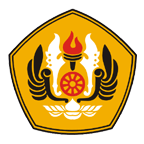Study of Physicochemical Characteristics of Kaolin from Belitung Regency
Abstrak
Kaolin is one of the abundant clay minerals on earth which has been widely used in various industries. kaolin as a raw material in drugs manufacturing must comply several requirements in Pharmacopoeia such as not exceeding the heavy metal content limits. In this study the analysis of heavy metal content (Pb, Sn, and As) was carried out on natural kaolin obtained from 3 different locations in Belitung regency. Testing of the brightness and particle size is also carried out to increase the value of kaolin as a pharmaceutical excipient. The highest recovery from kaolin was obtained in sample 3 which was 67.78%, while kaolin 1 and 2 which was 66.54, and 64.20%. Based on the results of heavy metal testing it is known that kaolin 1, 2, and 3 have a Pb content of 55.2, 0.0458 and 44.0 ppm, and As content of 1.05, 78.3, and 0.761 ppm. Whereas the Sn mean metal is only found in kaolin 2 which is 0.0034. White degree test results show that kaolin 1, 2 and 3 have a high brightness, namely 92.94%, 93.00%, 91.16%. From the results of particle size testing shows that all kaolin samples have size <2 μm.
Keywords: Characterization of Minerals, Heavy Metals, Kaolin
Teks Lengkap:
PDFReferensi
Awad M. E., Galindo A. L., López-galindo A., Setti M., El-rahmany M. M., Kaolinite in Pharmaceutics and Biomedicine. Int J Pharm. 2017; 533 (1): 34–48.
Awad M. E., López-Galindo A., El-Rahmany M. M., El-Desoky H. M., Viseras C. Characterization of Egyptian Kaolins for Health-Care Uses. Appl Clay Sci. 2017; 135: 176–189.
Rowe R. C., Sheskey P. J., Owen S. C., Handbook of Pharmaceutical Excipient 6th. Pharmaceutical Press. Chicago London. 2006. 378–380
Christian Z. C., John A. P., Shehu Z., Chemical Investigation of Kankara Kaolin for its Pharmaceutical Applications. Open Access Journal of Translational Medicine and Research. 2018; 2 (1) :2–4.
Williams, L. B. dan Haydel, S. E., Evaluation of the medicinal use of clay minerals as antibacterial agents, International Geology Review, 2010, 52(7–8), pp. 745–770.
Carretero M. I., and Pozo M. Applied Clay Science Clay and Non-Clay Minerals in the Pharmaceutical and Cosmetic Industries Part II . Active Ingredients. Appl Clay Sci. 2010; 47 (3–4) :171–181.
Khurana, I. S., Kaur, S., Kaur H., dan Khurana, R. K., Multifaceted role of clay minerals in pharmaceuticals, Future Science OA, 2015, 1(3), p. fso.15.6.
Estiaty L. M., dan Fatimah D., Pengolahan Kaolin Alam Cipatujah dan Bangka Belitung : Pengurangan Pengotor Silika dengan Pelarutan HF. Pus Penelit Geoteknologi LIPI. 2014; (ISBN 978-979-8636-23-3): 463–474.
Silva-Valenzuela M. G, Matos C. M., Shah L. A., Carvalho F. M. S., Sayeg I. J., Valenzuela-Diaz F. R., Engineering Properties of Kaolinitic Clay with Potencial Use in Drugs and Cosmetics. Int J Mod Eng Res. 2013; 3: 163–165.
Kemenkes RI. Farmakope Indonesia Edisi V. Kementrian Kesehatan Republik Indonesia. Jakarta. 2014.
Ramaswamy, S. dan Raghavan, P., Significance of Impurity Mineral Identification in the Value Addition of Kaolin – A Case Study with Reference to an Acidic Kaolin from India, Journal of Minerals and Materials Characterization and Engineering, 2011, 10(11), pp. 1007–1025.
Sunardi. Kajian Spektroskopi FTIR, XRD dan SEM Kaolin Alam Asal Tatakan, Kalimantan Selatan Hasil Purifikasi dengan Metode Sedimentasi. Sains dan Terapan Kimia. 2009; 137–149.
Zhang, R. , Li, L., Sultanbawa, Y., dan Xu, Z. P., X-ray fluorescence imaging of metals and metalloids in biological systems, American journal of nuclear medicine and molecular imaging, 2018, 8(3), pp. 169–188.
Kaemba A., Suryanto E., Mamuaja C. F., Karakteristik Fisiko-Kimia dan Aktivitas Antioksidan Beras Analog dari Sagu Baruk dan Ubi Jalar Ungu. J Ilmu dan Teknol Pangan. 2017; 5 (1): 1–8.
Aliwarga L. Proses Pemutihan Kaolin Cicalengka Untuk Pelapis Kertas. M.I.P.I. 2019; 13 (2) (171-178).
Liu, L., Shen, L., Li, W., Min, F., dan Lu, F., Study on the aggregation behavior of kaolinite particles in the presence of cationic, anionic and non-ionic surfactants, 2018, pp. 1–15.
Li, X. dan Qian, P., Identification of an exposure risk to heavy metals from pharmaceutical-grade rubber stoppers. Journal of Food and Drug Analysis. Elsevier Ltd. 2017. 25(3), pp. 723–730.
Mahurpawar, M., Effects of heavy metals on human health, International Journal of Reseacrh- Granthaalayah, 2015, 2350 (0530), pp. 2394–3629
Kumar R., Selective Flocculation of Low Grade Iron Ore Slimes Using Different Types of Polymers. Indian Journal of Chemical Technology. 2017. 24 (4) 411-416.
U.S. Pharmacopeia. The United States Pharmacopeia, USP 37 The National Formulary, NF 32. 2014 Rockville, MD: U.S. Pharmacopeial Convention.
DOI: https://doi.org/10.24198/ijpst.v7i2.25675
Refbacks
- Saat ini tidak ada refbacks.
| Switch to English Back to Top |
| View My Stats Penerbit Universitas Padjadjaran
Jurnal ini terindeks di :Creative Commons Attribution :
Based on a work at http://jurnal.unpad.ac.id/ijpst/ |
 Indonesian Journal of Pharmaceutical Science and Technology
Indonesian Journal of Pharmaceutical Science and Technology




